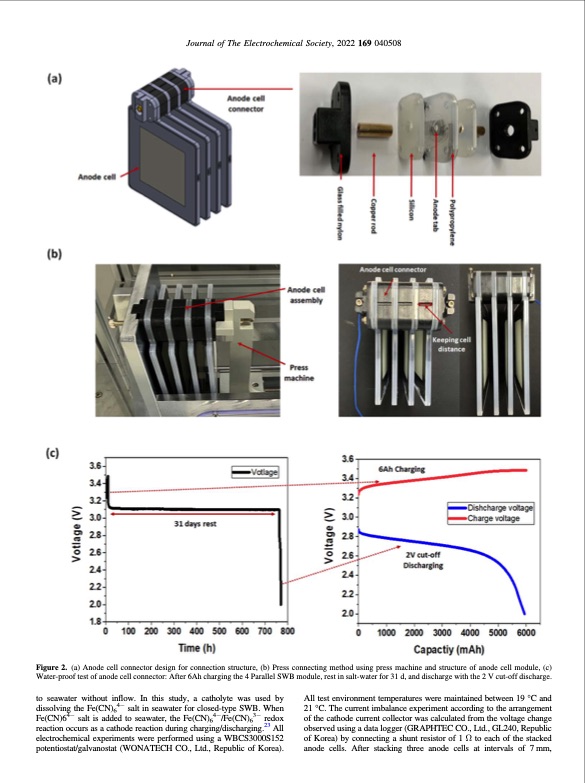
PDF Publication Title:
Text from PDF Page: 004
Journal of The Electrochemical Society, 2022 169 040508 Figure 2. (a) Anode cell connector design for connection structure, (b) Press connecting method using press machine and structure of anode cell module, (c) Water-proof test of anode cell connector: After 6Ah charging the 4 Parallel SWB module, rest in salt-water for 31 d, and discharge with the 2 V cut-off discharge. to seawater without inflow. In this study, a catholyte was used by dissolving the Fe(CN)64− salt in seawater for closed-type SWB. When Fe(CN)64− salt is added to seawater, the Fe(CN)64−/Fe(CN)63− redox reaction occurs as a cathode reaction during charging/discharging.23 All electrochemical experiments were performed using a WBCS3000S152 potentiostat/galvanostat (WONATECH CO., Ltd., Republic of Korea). All test environment temperatures were maintained between 19 °C and 21 °C. The current imbalance experiment according to the arrangement of the cathode current collector was calculated from the voltage change observed using a data logger (GRAPHTEC CO., Ltd., GL240, Republic of Korea) by connecting a shunt resistor of 1 Ω to each of the stacked anode cells. After stacking three anode cells at intervals of 7 mm,PDF Image | Development of Rechargeable Seawater Battery

PDF Search Title:
Development of Rechargeable Seawater BatteryOriginal File Name Searched:
Kim_2022_Electrochem-169_040508.pdfDIY PDF Search: Google It | Yahoo | Bing
Product and Development Focus for Salgenx
Redox Flow Battery Technology: With the advent of the new USA tax credits for producing and selling batteries ($35/kW) we are focussing on a simple flow battery using shipping containers as the modular electrolyte storage units with tax credits up to $140,000 per system. Our main focus is on the salt battery. This battery can be used for both thermal and electrical storage applications. We call it the Cogeneration Battery or Cogen Battery. One project is converting salt (brine) based water conditioners to simultaneously produce power. In addition, there are many opportunities to extract Lithium from brine (salt lakes, groundwater, and producer water).Salt water or brine are huge sources for lithium. Most of the worlds lithium is acquired from a brine source. It's even in seawater in a low concentration. Brine is also a byproduct of huge powerplants, which can now use that as an electrolyte and a huge flow battery (which allows storage at the source).We welcome any business and equipment inquiries, as well as licensing our flow battery manufacturing.| CONTACT TEL: 608-238-6001 Email: greg@salgenx.com | RSS | AMP |